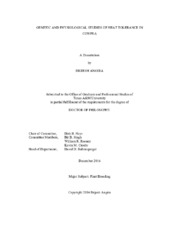| dc.description.abstract | Cowpea (Vigna unguiculata (L.) Walp.) is an important legume crop commonly
used for grains and for fodder in some parts of the world. It is grown in over 65 countries
worldwide. In the United States, it is primarily grown in the southern states, with major
production areas in Texas and California. A systematic breeding program was initiated at Texas A&M University to identify genetic variability for heat tolerance in cowpea
germplasm, and the variability was utilized to develop a RIL (recombinant inbred line)
mapping population by crossing a heat-tolerant (GEC) and a heat-susceptible (IT98K-
476-8) parent. The RILs were planted in three field environments – College Station in
2014, and Corpus Christi and Weslaco, Texas in 2015, and in a hot greenhouse to screen for heat tolerance, days to flowering, plant height, and other agronomic traits. The RILs were also genotyped using SNPs markers, and QTLs (quantitative trait loci) were mapped for the phenotypic traits measured.
Significant phenotypic variability was identified in cowpea germplasm. Both the
selected parents utilized to develop RILs were significantly different for all the measured
traits, and transgressive segregation was detected in the RIL population. A genetic
linkage map was constructed having 11 linkage groups using genotypic data, and one
significant QTL was detected on linkage group 3 (LOD of 2.78 and explained 7.66% of
variation) for heat-tolerance visual ratings in Corpus Christi, and another on linkage
group 10 (LOD of 3.86 and explained 10.64% of variation) for ratings in the greenhouse. For seed weight per plant (SWT), we have detected two QTLs, one on linkage group 3
(LOD of 7.86 and explained 17.05% of variation) and another on 10 (LOD of 5.07 and
explained 11.37% of variation). For number of pods per plant (PODN), three QTLs were
detected, one on linkage group 3 (LOD of 11.43 and explained 22.93% of variation) and
two on linkage group 10 (first – LOD of 3.34 and explained 5.93% of variation; second
– LOD of 4.04 and explained 7.62% of variation) using BLUPs (best linear unbiased
predictions). | en |


